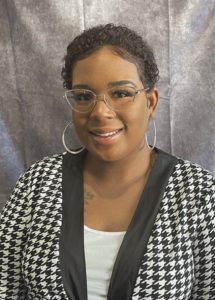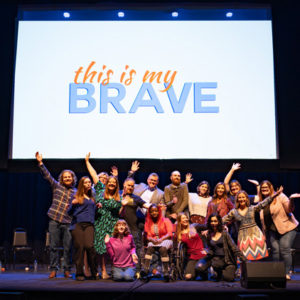Living with Bipolar Type II
by Jillian E-L Rouse
This blog post is part of This Is My Brave’s 2022 Awareness Days campaign. With World Bipolar Day occurring annually on March 30th, TIMB alum Jillian E-L Rouse is sharing her story in written form to help us continue our mission to put faces and names to stories of recovery. We are grateful for our alumni community that continues to show up and lead the way in ending the stigma surrounding mental health conditions.
Hi, my name is Jillian, and every day for the past twelve years or so I have lived with bipolar II disorder, and for ten of them I didn’t even know. I honestly thought the way I felt and acted was normal, and everyone who was telling me otherwise was wrong and misguided. I’ve been fully diagnosed for two years now. Let’s just say the road has been rocky, especially looking back when I couldn’t explain why I was the way I was. I was losing friends and relationships because I was too “crazy”. I thought my level of irritability was fine and not wanting to talk to my friends and family for weeks was normal. When I was too sad to leave my dorm room to go to class and got academically dismissed from two colleges, and everyone just thought I was lazy, I couldn’t explain it. I’d lay in my room and just cry for hours – no television, no phone, just lay there; I really could not get up and go. I felt so lost, so helpless, and so hopeless. But that’s not what you think about when you hear the term bipolar.
Bipolar disorder isn’t what you usually hear used among two people joking about one being moody for a second or two. You’re not “acting” bipolar for being happy and now all of a sudden you’re sad because something happened, like a breakup, and tomorrow or the next day you’re okay again. According to the National Institute of Mental Health, “Bipolar disorder (formerly called manic-depressive illness or manic depression) is a mental disorder that causes unusual shifts in mood, energy, activity levels, concentration, and the ability to carry out day-to day tasks. Bipolar I Disorder— defined by manic episodes that last at least 7 days, or by manic symptoms that are so severe that the person needs immediate hospital care. Usually, depressive episodes occur as well, typically lasting at least 2 weeks. Bipolar II Disorder— defined by a pattern of depressive episodes and hypomanic episodes, but not the full-blown manic episodes that are typical of Bipolar I Disorder.” Bipolar disorder isn’t a lot of things, but it is a lot.
Bipolar disorder for me is depression first; two or three months of pure sadness, sadness my favorite food or television show can’t cure. It’s watching my family and friends try to make me happy while I make them sad. This disease is messy rooms, poor hygiene, and calling off work. It’s me having suicidal ideations and needing to be placed into a psychiatric hospital. It’s long days and restless nights. Bipolar disorder is losing interest in everything I once loved like crafting and cooking. Also, it’s me needing to commit to consistent help from counselors and psychiatrists. Medication is also a part of bipolar disorder for me.
On the other side bipolar depression is hypomania (the up). Spending a lot of money, risky behaviors, and excessive cleaning. Hypomania is owning three hundred of something when you should only have three, going to get tattoos and piercings you’ll soon regret, and cleaning all of the things you hadn’t in months. For four to five days, I won’t sleep after a three month depressive episode, and if I do it’s cat naps.
You see, bipolar disorder isn’t your girlfriend being mad at you because you ate her food. Bipolar disorder is not fun nor is it funny. It’s a serious mental health condition where more than just the person living with it is affected by it. As stated above, when I hurt, my family hurts. The way mental illnesses are referenced in general, especially bipolar disorder, contribute to the stigma associated with them. Stigma stops people dead in their tracks from seeking help or even talking about their issues to begin with. We must talk about it but in the right context. We have to encourage people to seek help, there’s no shame in doing so. Everyone needs a shoulder to cry on sometimes. We have to stop viewing peoples’ weaknesses as such and instead view them as strengths. Let’s face it – someone battling something so powerful and winning every day is strong. So, how can a person come to terms with this disease and learn to live with it?
One way I’ve learned to live with this disease is by staying connected and surrounded by the people I love and who love me. My husband and my mother are my number one supporters, although I could include others in that spot as well, they lift me up almost daily even though I’m better now than I was years ago. My brother, grandparents, and close friends also play a big part. They all check on me regularly. They know that winters are harder for me than the summer. They know the shows on television I can not watch. They ask questions. If I’m overwhelmed, stressed, or unhappy, they try to help remove it. My circle knows my triggers and what gets me down because they know that’ll eventually lead to me going up. Most importantly, I know I can reach out to them at any given time. We have code words for emergencies, as well as how many times to call in a row. All in all, they’ve learned with me and never give up even when times are hard.
So you see, bipolar isn’t just a word. It’s real, and it’s life for some. Bipolar disorder seems to be a never ending, slow moving roller coaster without the excitement or thrill. For me, the lows are long and the highs are quick, but the damage always proves itself. Having bipolar disorder is exhausting, but we must remember that there is help, and there are people who love and care about us. There is a light at the end of the tunnel, no matter how dim it looks now. Bipolar disorder is tough but I’m tougher, and so are you. I’m Jillian and I live with bipolar II disorder, but bipolar disorder isn’t me.

About Jillian:
Jillian E-L Rouse is a 28-year-old peer support specialist, student, and mental health and substance use disorder advocate. She has been living with multiple mental health illnesses for over a decade; with the knowledge gained throughout her journey, she hopes to help a multitude of others. Jillian is currently seeking her bachelor’s degree in Psychology. After receiving such degree along with her master’s degree, Jillian plans to open her own drop-in center. Becoming aware of her mental health and accepting it for what it is, while also understanding that it does not define her, has been the biggest puzzle piece to her journey to peace and wellness.
In her free time, she enjoys planning events like birthday parties and weddings. She also loves to cook, bake, and craft. Jillian is married with three dogs, all very spoiled. Self-care is very important in her mental health journey so bubble baths, getting eight hours of sleep, and following her treatment plan to the tee are some of her top priorities. Cruising and just vacationing in general are also a part of her self care regimen.
Jillian is also the author of My Hidden Jewels, a self-help mental health journal. It is composed of mindfulness exercises, self-awareness activities, and journaling pages and is now available on Amazon.
Jillian shared her story in This Is My Brave – Stories from the Black Community, Vol. 2 in 2021. Watch her original performance on our YouTube channel.

